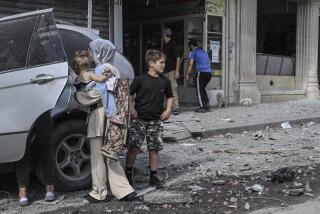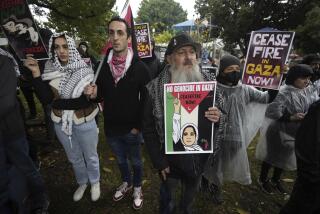The Wrath That Did Not Pass : THE HOLOCAUST; The Fate of European Jewry <i> By Leni Yahil (Oxford University Press: $35; 808 pp.) </i>
- Share via
Israeli historian Leni Yahil’s mammoth, sweeping study of the Nazis’ extermination of European Jewry does not provide cuddly reading on a winter’s day. It is tough going, mainly because of the horrific nature of the material. But at a time when the world apparently is so “tired” of “paying for Holocaust guilt,” when the very fact of the extermination of 5.5 million Jews is denied by so-called Revisionists and denigrated by some “liberals” who ask, “What about all the other victims?,” such a book becomes essential reading--even if it may present an arduous task. For in the words of Simon Halkin, which serve as the book’s dedication, “Only the ones who remember live. . . .”
The author, professor emeritus at Haifa University and a member of the editorial board of the Yad Vashem Holocaust Memorial in Jerusalem, begins her narrative in 1932, with the rise of Hitler and the National Socialists.
Throughout the ‘30s, the Jews were constantly portrayed by the Nazis as a demonic power, mainly because the leading character in the world’s most brutal drama--the little Austrian corporal with the erect arm--was totally obsessed by the Jews and possessed by the demon of history. Already in the early 1920s, Hitler had written in his ranting fashion that the Jews should be systematically starved to death, that they should be ghettoized and driven to commit mass suicide.
Another Adolf, Austrian-reared Eichmann, took on a major role in the tragic play as early as 1938, with the forced emigration of some Jews and the arrests of 2,200 “asocial Jews” who were sent to Dachau, Buchenwald and Sachsenhausen concentration camps for such crimes as illegal parking.
Yahil divides her study of the annihilation of European Jewry into three parts: the phase from 1932 until the outbreak of war on Sept. 1, 1939; the initial stages of the war until the invasion of Russia in the spring of 1941, and the systematic extermination that was spelled out by the Wannsee Conference of January, 1942, and which lasted until the Nazis were defeated in May, 1945.
Hitler fastened on the Jews, in Yahil’s opinion, because they brought God’s Ten Commandments into the world. And Hitler said that “no Jewish god will save the democracies” from the Nazi revolution.
With typical German efficiency, the Nazis ran pilot projects early on for the eventual mass extermination. Within five weeks of the invasion of Poland, the Germans had streamlined transportation, established transit camps and set up the system of fabrications and deceptions designed to herd the Jews toward their death. Jewish property was systematically plundered, councils were set up to expedite the Nazis’ plans, and the ghettoization was quickened. The Nazis exterminated what they called the “pustules of pestilence.”
But across the vast canvas of Europe, circumstances differed greatly from district to district and town to town, and within thousands of communities whose sizeable Jewish populations were submerged in murder and mayhem.
The author, sensibly, chooses examples ranging from the middle-sized town of Piotrkow, Poland, where 11,000 Jews formed about one-quarter of the population, to the big city of Lodz, where Jews had lived for 400 years.
The Piotrkow Jews, though constantly robbed, beaten and tortured, believed their trials would soon pass, that if they could only withstand the whirlwind, justice would prevail and they would be free to leave accursed Eastern Europe for the ancestral Jewish homeland in Palestine. They subscribed to what the prophet Isaiah had preached: “Hide yourself for a while/ Until the wrath is past.”
Yahil touches on all aspects of this complex and torturous story, including sketches of the various “kings of the Jews”--heads of Jewish councils (the Judenrate ) who ranged from the saintly to the profane. But she shows sensitivity throughout her book, refraining from facile judgments of people who lived through the unimaginable.
One, Mordechai Chaim Rumkowski of Lodz, believed he was a Moses chosen to lead his people out of bondage, but he became like an absolute dictator, and put his image on postage stamps. In stark contrast, his cousin, Adam Czerniakow, who headed the Warsaw Judenrat , the biggest Jewish community in Europe, was an unpretentious, dedicated man who had “a historic role in a besieged city,” as he recorded in his diary, and who eventually committed suicide.
The main problem for the Jews was that they had no standing in the political world. They were considered to be Frenchmen or Poles or Ukrainians, and not Jews--except by the Nazis. Because they were not recognized as a nation, they were not protected by international organizations like the Red Cross. Yahil only touches on this crucial point, though she does go back to it at the end of her book, in the chapters on the issue of rescue.
What she does do well and in detail is to chronicle the Nazis’ aim of exterminating the Jews through starvation, slave labor and mass execution--what Field Marshal Goering spelled out for the first time in a July 31, 1941, directive to Reinhard Heydrich: the “execution of the intended final solution of the Jewish question.”
At that time, the solution was mass shooting--taking thousands of Jews out to the edges of huge pits and trenches, machine-gunning them, and covering the heaving mass graves with lime and earth. Babi Yar in the Ukraine represented the peak of this method of Aktion , which eventually took 1 million lives. The Nazis slew 34,000 Jews in two days at this ravine in the Kiev woods. But the Soviets added to the crime by refusing, to this day, to call the victims Jews: They were “Ukrainians” or “Soviet citizens.”
Yahil is the first to admit that the story of the extermination of European Jews--which some regard as the seminal event of all history, and not just some “particularistic” obsession of the Jewish people--cannot be captured by even the greatest painter or writer or composer or historian. For some reason, great historians--scholars of the caliber of Carl Shorsky, for example--have shied away from Holocaust studies. Marc Bloch, the eminent French-Jewish historian of the feudal era, could have written such a work, had he not been exterminated with the millions.
Yahil has contributed to the literature, ranging between the general (such as the evolving means of extermination) and the specific--as in her description of the nefarious walkway leading between Camps 1 and 2 at Treblinka, a path lined with sadistic SS men holding dogs and whips, which the Germans dubbed the “Way to Heaven.”
One of the essential elements of the story is that the Allies may have saved perhaps a million of the Holocaust victims, had they sought special status for Hitler’s primary target. After her country-by-country chronicle of the extermination, Yahil concludes: “The fact that the Jews lacked an independent political status and were regarded as nationals of one country or another obviated the need to recognize the shared fate of the Jews as a people.”
But though this is a valuable and solid book, it is uneven in terms of organization and craftsmanship. The author’s dispassionate tone generally benefits the work, but some of her assumptions about rescue--apparently based exclusively on secondary sources--seem naive and superficial. She glosses over the heated debates within the Zionist and Jewish worlds, for example, though this may be understandable at a time when the victim is increasingly blamed for the crime.
More to Read
Sign up for our Book Club newsletter
Get the latest news, events and more from the Los Angeles Times Book Club, and help us get L.A. reading and talking.
You may occasionally receive promotional content from the Los Angeles Times.








